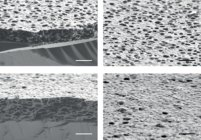
In this way, smart switching between ‘open’ and ‘closed’ is possible, making the membrane suitable for applications such as biosensors, chemical analysis and katalysis.
The pore size of the smart membranes can be adjusted from the outside by introducing iron within the polymer. Using an electric signal or a chemical reaction, the pore size can be adjusted using controlled adding or extracting of electrons to and from iron.
Thanks to this adjustable pore size, the permeability and selectivity of the membrane can be also tuned for separation purposes or controlled release in the analysis and separation of proteins, for example. Another advantage of the new membranes is the change in colour that takes place, making the process of protein detection and analysis easier to spot.
Silver catalyst
Another application of the smart membrane is in catalysis. Whilst the pore size and permeability can be altered using a chemical reaction with silver salt, nanosize particles of silver are deposited on the membrane at the same time. Silver is an important catalyst in many applications.
The membrane research was conducted in the Materials Science and Technology of Polymers group, led by Professor Julius Vancso. The paper ‘Breathing cells on command: redox-responsive porous membranes from poly(ferrocenylsilane)’ has been published in the journal ‘Angewandte Chemie’.

